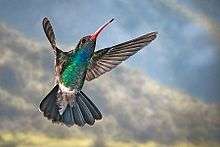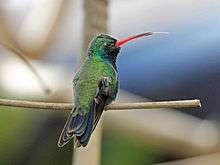Broad-billed hummingbird
The broad-billed hummingbird (Cynanthus latirostris) is a medium-sized hummingbird of North America. It is 9–10 cm long, and weighs approximately three to four grams.
| Broad-billed hummingbird | |
|---|---|
 | |
| Scientific classification | |
| Kingdom: | Animalia |
| Phylum: | Chordata |
| Class: | Aves |
| Order: | Apodiformes |
| Family: | Trochilidae |
| Genus: | Cynanthus |
| Species: | C. latirostris |
| Binomial name | |
| Cynanthus latirostris Swainson, 1827 | |
| Extent of occurrence | |
Distribution
The breeding habitat is in arid scrub of the Sonoran Desert—Chihuahuan Desert ecotone and the Madrean Sky Islands in southeastern Arizona and extreme southwestern New Mexico of the Southwestern United States and northern Sonora of Northwestern Mexico.
Outside its breeding range, it will occasionally stray, from southernmost California to Texas, Georgia, and Louisiana.
Doubleday's hummingbird is sometimes considered a distinct species by some taxonomic authorities, however the American Ornithological Society still considers it conspecific with this species.
Description
Adults are colored predominantly a metallic green on their upperparts and breast. The undertail coverts are predominantly white. The tail is darkly colored and slightly forked.
The bill of the male is straight and very slender. It is red in coloration, and shows a black tip. His throat is a deep blue. The female is less colorful than the male. She usually shows a white eye stripe.
The female builds a nest in a protected location in a shrub or tree. Females lay two white eggs. This hummingbird is partially migratory, retreating from northernmost areas during the winter to Central Mexico.
These birds feed on nectar from flowers and flowering trees using a long extendable tongue, or catch insects on the wing.
Gustatory sugar thresholds and sugar selection
Studies have reflected that pollinators have different dietary preferences according to the sugar composition presented in the nectar. Nectar is a liquid solution composed of three main sugars: sucrose, glucose and fructose. In a study which presented eight C. latirostris to feeders containing a sugar solution or pure water, it was revealed that the Broad-billed hummingbird has sugar preferences that can be affected by different mechanisms, both pre-and post ingestive. It was discovered that at low concentrations, gustatory thresholds may play an important role in sugar selection. However, at medium and high concentrations, sugar assimilation rates and food processing can be used to explain the sugar selection in these birds.[2]
References
- BirdLife International (2016). "Cynanthus latirostris". The IUCN Red List of Threatened Species. IUCN. 2016: e.T22725767A94902093. doi:10.2305/IUCN.UK.2016-3.RLTS.T22725767A94902093.en. Archived from the original on 14 January 2018. Retrieved 13 January 2018.
- Medina-Tapia, Nubia (March 2012). "Do hummingbirds have a sweet-tooth? Gustatory sugar thresholds and sugar selection in the broad-billed hummingbird Cynanthus latirostris". Comparative Biochemistry and Physiology Part A: Molecular & Integrative Physiology. 161 (3): 307. doi:10.1016/j.cbpa.2011.11.012.

